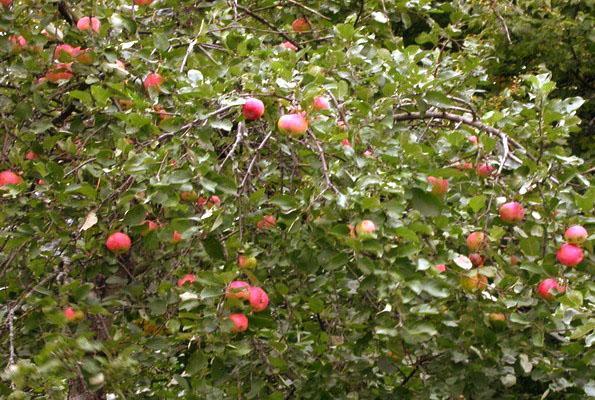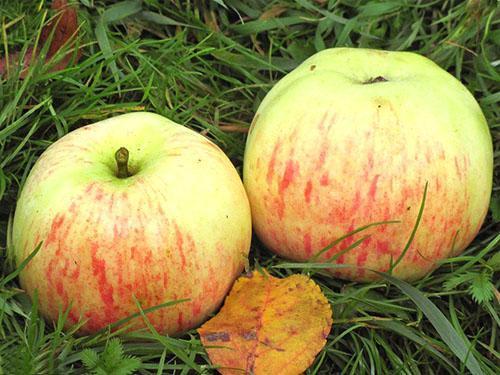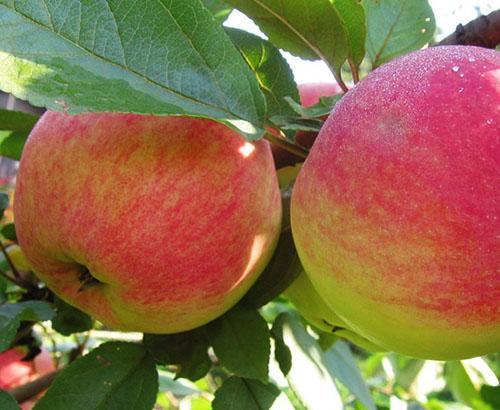Apple tree varieties for the Leningrad region
 The conditions for gardening in the Leningrad region cannot be called ideal or even good. Neither the climate of the region nor the composition of the rather poor soils contributes to the cultivation of fruit trees. The thickness of the fertile layer in some areas does not exceed 20-30 cm, gardens have to be set up on peat bogs, sands and loams.
The conditions for gardening in the Leningrad region cannot be called ideal or even good. Neither the climate of the region nor the composition of the rather poor soils contributes to the cultivation of fruit trees. The thickness of the fertile layer in some areas does not exceed 20-30 cm, gardens have to be set up on peat bogs, sands and loams.
Harvests in the North-West region are very difficult, therefore the apple varieties offered by breeders for the Leningrad region are distinguished by high frost resistance, resistance to diseases and pests, and the fruits on such trees should ripen as early as possible.
Apple tree Chosen
The ripening of the fruits of the Chosen apple falls in the last decade of August or the first days of September.

A medium-sized apple tree with a wide sparse crown is distinguished by strong attachment of skeletal branches. Shoots on trees are powerful, short, with noticeable pile and large leathery leaves, also pubescent on the back. The ovaries are mainly formed on the ringlets, and the mass ripening of fruits often begins in the sixth year after planting in the ground. The rather large fruits of the apple tree Chosen One have a flattened-rounded shape with barely noticeable ribs, smooth yellow skin and red shading almost over the entire surface. The fruits retain their sweet and sour harmonious taste and juiciness until November.
Apple tree Melba
 Melba is one of the oldest foreign varieties of apple trees that appeared in the Russian garden more than a hundred years ago. For the first time, the Melba apple tree, obtained in Ottawa, in 1898, and since then, the fragrant juicy fruits are loved in many regions of the world, including Russia, where the variety is zoned in the Leningrad region. Active fruiting of apple trees with a rounded crown begins 4–5 years after planting. Most of the ovary is formed and matured on annelids, and the shoots of medium length and thickness are pubescent and covered with oval, slightly curved leaves of a rather light shade.
Melba is one of the oldest foreign varieties of apple trees that appeared in the Russian garden more than a hundred years ago. For the first time, the Melba apple tree, obtained in Ottawa, in 1898, and since then, the fragrant juicy fruits are loved in many regions of the world, including Russia, where the variety is zoned in the Leningrad region. Active fruiting of apple trees with a rounded crown begins 4–5 years after planting. Most of the ovary is formed and matured on annelids, and the shoots of medium length and thickness are pubescent and covered with oval, slightly curved leaves of a rather light shade.
Fruiting of young Melba apple trees takes place annually, but breaks can be observed with age, although the overall yield of the variety remains high.
Apples ripen towards the end of August, are medium to large and round or slightly conical in shape. The very thin, light-colored peel of ripe fruits is decorated with an intense striped or blurred blush. Among all varieties of apple trees for the Leningrad Region, Melbu is distinguished by snow-white, delicate pulp with a bright aroma and excellent taste. Despite the apparent vulnerability, apples are well transported and can be kept cool until mid-winter.
Apple tree Aelita
 In the Northwest region, Aelita apple trees, grown by crossing Brown Striped and Welsey, were released in 1999. And for the first time the variety was obtained at the V.N. I. V. Michurin by the famous breeder, the author of many popular varieties of fruit trees S. I. Isaev.
In the Northwest region, Aelita apple trees, grown by crossing Brown Striped and Welsey, were released in 1999. And for the first time the variety was obtained at the V.N. I. V. Michurin by the famous breeder, the author of many popular varieties of fruit trees S. I. Isaev.
Despite their tallness, trees with a crown of a wide pyramidal shape have a pronounced winter hardiness, are not affected by scab and withstand abundant harvests even in the conditions of the Leningrad Region. Flowering and ovary formation occurs on perennial straight shoots covered with elongated dark green leaves with a prominent pointed conic.
The rounded-conical fruits of the Aelita apple tree weighing about 120 grams have a regular shape and a yellow-green basic color, on which a solid or striped red blush stands out well.
Apples have yellowish, fine-grained flesh, pleasant to the taste, the best qualities of which are revealed in mid-September, while the fruits are removed from the branches two weeks earlier and stored until the new year.
Apple tree Auxis
 In the Leningrad region and the environs of Kaliningrad, the variety bred in Lithuania from the crossing of the Macintosh and red Grafenstein varieties, came in the last century and has established itself as winter-hardy and unpretentious.
In the Leningrad region and the environs of Kaliningrad, the variety bred in Lithuania from the crossing of the Macintosh and red Grafenstein varieties, came in the last century and has established itself as winter-hardy and unpretentious.
The apple variety Auxis enters the fruiting season five years after the seedling is planted in the ground. By this time, a medium-sized tree with a round crown is formed, capable of producing significant and regular yields.
Flowering starts in the second half of May, and by the end of summer large, up to 140 grams in weight, apples of the correct shape ripen. In September, at the time of removal from the branches, the apples are greenish or yellow in color with a carmine blush. And after 2-3 weeks, the main color becomes yellow, the blush spreads almost over the entire fruit. You can save the sweet and sour dessert fruits of the Auxis apple tree with yellow dense pulp until winter, and when cooled, the apples do not lose their quality until March.
Description and photo of the Welsey apple tree
 Bred in 1860, the American cultivar of the Welsey apple tree is approved for a number of regions of the European part of Russia, including the Leningrad region. Therefore, many gardeners know Welsey apple trees by description and photo, and also have their own experience of growing medium-sized trees that winter well in a harsh climate and are not prone to scab disease. Young apple trees give their first harvest at the age of 4–5 years.
Bred in 1860, the American cultivar of the Welsey apple tree is approved for a number of regions of the European part of Russia, including the Leningrad region. Therefore, many gardeners know Welsey apple trees by description and photo, and also have their own experience of growing medium-sized trees that winter well in a harsh climate and are not prone to scab disease. Young apple trees give their first harvest at the age of 4–5 years.
Thanks to these qualities of the Welsey-based variety, more than three dozen new varieties of apple trees have been bred today.
The variety can be called one of the leaders in terms of productivity, since an apple tree with a rounded crown can yield more than 250 kg of fruit per season. True, branches growing at an acute angle can withstand such a load only if there are good supports, otherwise the breaking off of large skeletal branches cannot be avoided. The opening of the often folded or curved small leaves is preceded by the mass appearance of pale pinkish or lilac flowers.
Apples of the winter variety Welsea are medium in size, flattened and covered with a smooth skin of a light green or yellowish base color. According to the photo and description, the fruits of the Welsey apple tree have an abundant, dark red, solid or blurry-banded blush and a white or greenish flesh. Harvesting takes place closer to the end of September, and it is impossible to hesitate in picking the fruits, literally in a week the apples begin to crumble. In favorable warm years, ripe fruits immediately after harvest have a sweet and sour taste, but if the season was rainy, consumer properties decrease. By keeping an eye on the humidity in the store, you can save the Wellsie apples that quickly lose their juiciness until the end of winter.
Druzhnoe apple-tree
 The fast-growing apple variety Druzhnoe, resistant to common diseases and frosts, is the result of the work of the breeders of the local Leningrad station, who used the unpretentious Antonovka vulgaris and the Jonathan variety for crossing.
The fast-growing apple variety Druzhnoe, resistant to common diseases and frosts, is the result of the work of the breeders of the local Leningrad station, who used the unpretentious Antonovka vulgaris and the Jonathan variety for crossing.
Already in the fourth year, in the second half of May, an apple tree with a dense crown blooms and at the end of September it gives the first harvest, consisting of large fruits weighing up to 170 grams. The apples have a round-conical shape and a yellow skin with a green tint. The ribs are clearly visible on the surface of the fruit. The blush is reddish red, speckled or banded.The apples are very dense, sweet and sour, retaining juiciness and flavor until early spring. This quality, together with high yields, gives additional value to this apple variety for the Leningrad region.
Apple tree Antey
 The large-fruited winter apple variety Antey is an achievement of Belarusian scientists. The variety is obtained from pollination of the Belarusian Raspberry with the pollen of a hybrid apple tree from varieties Babushkino and Newtosh. The variety with good winter hardiness and regular fruiting was highly appreciated by Belarusian gardeners, and also aroused serious interest in the North-West region. A compact tree with a transparent, easily pruned crown, up to 2.5 meters high, begins to form an ovary 2-3 years after planting and annually produces up to 50 kg of strong apples that are stored for up to 6-7 months.
The large-fruited winter apple variety Antey is an achievement of Belarusian scientists. The variety is obtained from pollination of the Belarusian Raspberry with the pollen of a hybrid apple tree from varieties Babushkino and Newtosh. The variety with good winter hardiness and regular fruiting was highly appreciated by Belarusian gardeners, and also aroused serious interest in the North-West region. A compact tree with a transparent, easily pruned crown, up to 2.5 meters high, begins to form an ovary 2-3 years after planting and annually produces up to 50 kg of strong apples that are stored for up to 6-7 months.
The number of Anthea fruits, as well as their quality, are almost not affected by weather conditions, which turns out to be an additional advantage in the northern regions of Russia.
Almost entirely covered with a dark red or burgundy blush, the fruits weigh about 200 grams and have a regular round-conical shape. On apples, a waxy bloom is clearly visible, giving the fruit a bluish or purple hue. Apple picking, depending on the weather in a particular region, begins at the end of September or in the first weeks of October. You can taste the ripe sweet and sour fruits of the Antey apple tree in December. The variety is stored until the middle of next spring.
Apple tree Asterisk
 Another winter apple variety for the Leningrad region was obtained at the V.N. I.V. Michurin. The asterisk is the result of crossing Anis and Lithuanian Pepinka. The variety begins to bear fruit six years after grafting, and the apples ripen annually, and the yields are large enough. The culture is resistant to scab, tolerates winters well in the Leningrad region. Mature, vigorous trees with a spreading or slightly drooping crown lend themselves well to shaping.
Another winter apple variety for the Leningrad region was obtained at the V.N. I.V. Michurin. The asterisk is the result of crossing Anis and Lithuanian Pepinka. The variety begins to bear fruit six years after grafting, and the apples ripen annually, and the yields are large enough. The culture is resistant to scab, tolerates winters well in the Leningrad region. Mature, vigorous trees with a spreading or slightly drooping crown lend themselves well to shaping.
Apple trees Asterisks respond positively to pruning, responding with larger fruits and laying a mass of flower buds on the middle and outer part of the crown.
Apples during winter ripening remain fresh and do not lose their consumer qualities until the end of February. With abundant fruiting of the Asterisk apple tree, the fruits are medium-sized, even flattened with a smooth green skin. By the end of the growing season, apples are densely covered with a dark carmine blurred blush. And their juicy sweet and sour pulp, usually greenish, may have a pink tint under the skin.
Apple tree Renet Chernenko
 The apple variety Renet Chernenko, which resulted from free pollination of the pepine Renet, is zoned in certain regions of the North-West region, including the suburbs of St. Petersburg. Apple trees are vigorous, hardy, tolerate severe frosts well and are resistant to scab damage. For modern varieties, fruiting begins relatively late - after 6-7 years after planting in the ground, while the tree is capable of producing from 60 to 170 kg of apples of late winter ripening period.
The apple variety Renet Chernenko, which resulted from free pollination of the pepine Renet, is zoned in certain regions of the North-West region, including the suburbs of St. Petersburg. Apple trees are vigorous, hardy, tolerate severe frosts well and are resistant to scab damage. For modern varieties, fruiting begins relatively late - after 6-7 years after planting in the ground, while the tree is capable of producing from 60 to 170 kg of apples of late winter ripening period.
The dull, medium-sized fruits of the Renet Chernenko apple tree have a regular flattened-rounded shape, are painted in greenish or yellow tones and on the side facing the sun are covered with a bright red blush in the form of stripes or densely spaced specks. The sweet and sour harmonious taste of the white dense pulp lasts almost until the end of spring.
Apple tree Tellisaare
 The high-yielding Tellisaare apple variety, showing medium winter hardiness, resistant to scab, was obtained by Estonian amateur breeders, and today it is recommended for cultivation in the Leningrad region.
The high-yielding Tellisaare apple variety, showing medium winter hardiness, resistant to scab, was obtained by Estonian amateur breeders, and today it is recommended for cultivation in the Leningrad region.
The apple trees of this variety have a dense rounded crown that can withstand solid yields of small, up to 100 grams in weight, flattened or rounded fruits with a noticeable bevel on one side. The first ovary appears 4–5 years after planting. In years of abundant fruiting, the fruits sometimes become smaller, or the yield of the next year decreases.The dense apples picked in September have an oily greenish skin with a slight reddish-brown blush.
By October, when the Tellisaare apple tree is ready to eat, the light green pulp becomes juicy, aromatic and has a good sweet and sour taste. The harvests of this variety are of high quality, the apples are easy to transport and store until mid-February.